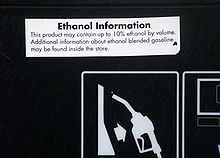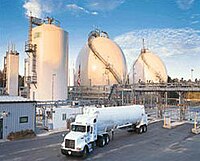Renewable fuels
Renewable Fuels are
Rationale for renewable fuels
The International Energy Agency's World Energy Outlook 2006 concludes that rising oil demand, if left unchecked, would accentuate the consuming countries' vulnerability to a severe supply disruption and resulting price shock. Renewable biofuels for transport represent a key source of diversification from
Hubbert's
Furthermore, the conclusion that anthropogenic greenhouse gas emissions are causing climate change, along with regional geopolitical instabilities have challenged nations to act to develop both alternative and carbon-neutral sources of energy. Renewable fuels are therefore becoming attractive to many governments, who are beginning to see sustainable energy independence as a valuable asset.
On December 19, 2007, President Bush signed into law the
According to the International Energy Agency (IEA),
Biofuel


Biofuel is a type of fuel whose energy is derived from biological
Biodiesel is made from vegetable oils and animal fats. Biodiesel can be used as a fuel for vehicles in its pure form, but it is usually used as a diesel additive to reduce levels of particulates, carbon monoxide, and hydrocarbons from diesel-powered vehicles. Biodiesel is produced from oils or fats using transesterification and is the most common biofuel in Europe.
In 2010 worldwide biofuel production reached 105 billion liters (28 billion gallons US), up 17% from 2009, and biofuels provided 2.7% of the world's fuels for road transport, a contribution largely made up of ethanol and biodiesel.[8] Global ethanol fuel production reached 86 billion liters (23 billion gallons US) in 2010, with the United States and Brazil as the world's top producers, accounting together for 90% of global production. The world's largest biodiesel producer is the European Union, accounting for 53% of all biodiesel production in 2010.[8] As of 2011, mandates for blending biofuels exist in 31 countries at the national level and in 29 states/provinces.[9] According to the International Energy Agency, biofuels have the potential to meet more than a quarter of world demand for transportation fuels by 2050.[10]
Pyrolysis oil is another type of fuel derived from the lignocellulosic fraction of biomass. By rapidly heating biomass in the absence of oxygen (pyrolysis), a liquid crude can be formed that can be further processed into a usable bio-oil. As opposed to other biofuels, pyrolysis oils use the non-edible fraction of biomass and can occur on the order of milliseconds and without the need for large fermentation reactors.[11]
Hydrogen fuel

The biological production of hydrogen fuel has been a topic of research since at least the 1970s. Hydrogen gas can be produced from biomass sources like agricultural and forest residues, consumer waste, and other specific agricultural crops.
There are also several physico-chemical methods for producing hydrogen; most of these methods require electrolysis of water. When this process draws its power from renewable energy sources like
Synthetic fuel (electrofuel)
Electrofuels, also known as e-fuels or synthetic fuels, are a type of drop-in replacement fuel. They are manufactured using captured carbon dioxide or carbon monoxide, together with
The process uses carbon dioxide in manufacturing and releases around the same amount of carbon dioxide into the air when the fuel is burned, for an overall low carbon footprint. Electrofuels are thus an option for reducing
Processed engineered fuel
PEF is a partial replacement for fossil fuels in cement kilns. It has significant calorific value and can be used as a fuel substitute for coal and gas in high-combustion facilities. PEF facilities typically divert waste from landfill, reducing demand for non-renewable coal and reducing waste to landfill.
See also
- Electrofuel
- IRENA
- Power to gas
- Renewable natural gas
- Solar fuel
- Syngas
References
- ^ "Technology". Carbon Recycling International. 2011. Archived from the original on 2013-06-17. Retrieved 2012-07-11.
- ^ Contribution of Renewables to Energy Security
- ^ Biomass for biofuel isn't worth it
- ^ Issue Update: Renewable Fuels Retailer Liability
- ^ International Energy Agency (2006). World Energy Outlook 2006 Archived 2007-09-28 at the Wayback Machine p. 8.
- ^ Biotechnology Industry Organization (2007). Industrial Biotechnology Is Revolutionizing the Production of Ethanol Transportation Fuel Archived 2006-02-12 at the Wayback Machine pp. 3-4.
- .
- ^ a b "Biofuels Make a Comeback Despite Tough Economy". Worldwatch Institute. 2011-08-31. Retrieved 2011-08-31.
- ^ REN21 (2011). "Renewables 2011: Global Status Report" (PDF). pp. 13–14.
{{cite web}}: CS1 maint: numeric names: authors list (link) - ^ "IEA says biofuels can displace 27% of transportation fuels by 2050 Washington". Platts. 20 April 2011.
- ^ Huber, George (2007). "Breaking the Chemical and Engineering Barriers to Lignocellulosic Biofuels: Next Generation Hydrocarbon Biorefineries".
{{cite journal}}: Cite journal requires|journal=(help) - ^ a b c d New Horizons for Hydrogen (PDF), National Renewable Energy Laboratory, 2003, archived from the original (PDF) on 2016-03-04
- ^ Wired, It Came from the Swamp: Reengineering Algae To Fuel The Hydrogen Economy, accessed September 17, 2007.
- ^ The Register, Pond life: the future of energy, accessed September 17, 2007.
External links
 Media related to Renewable fuels at Wikimedia Commons
Media related to Renewable fuels at Wikimedia Commons
